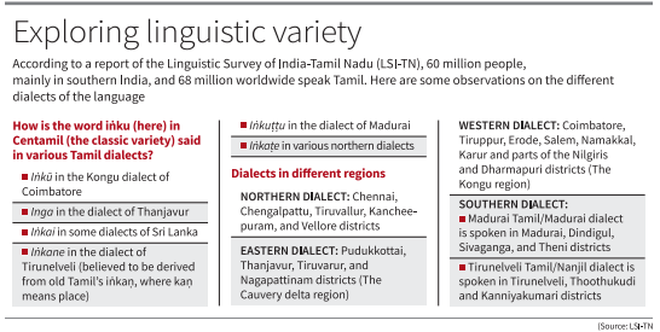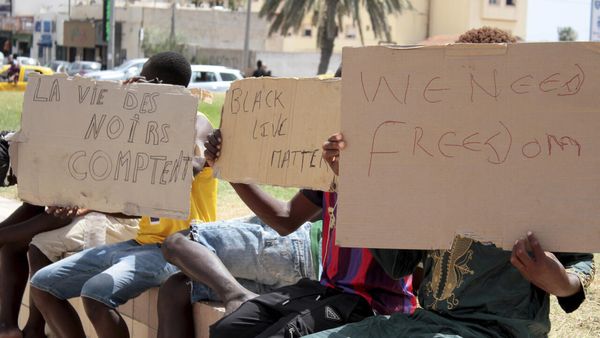
Linguistic pride has remained an integral feature of Tamil Nadu. At the same time, over several centuries, people speaking multiple Tamil dialects have struck a harmonious balance with speakers of 10 mother tongues of the ‘Dravidian family’ and one mother tongue of the ‘Indo-Aryan family’.
A report of the Linguistic Survey of India-Tamil Nadu (LSI-TN), published in July by the Language Division of the office of the Registrar-General & Census Commissioner of India (RG&CCI), highlights some interesting aspects.
Based on the field data collected as recently as 2021-22, the report classifies the languages of Badaga, Chetti Bhasha, Irula/Iruliga, Kathodi, Kota, Maliyad, Pania, Toda, Solaga and Urali as the mother tongues of the ‘Dravidian family’ spoken in Tamil Nadu. Besides, it identifies another mother tongue, Saurashtra/Saurashtri, spoken in some parts of the State, as belonging to the ‘Indo-Aryan family’.
Millions of speakers
According to the report, 60 million speakers, mainly in southern India, and 68 million worldwide speak Tamil. While language is inclusive of its variant mother tongues, mother tongue is exclusive. Interestingly, the 2011 Census had pointed out that 96 mother tongues with a speakers’ strength of over 10,000 were recorded in Tamil Nadu. Overall, people speaking 142 mother tongues were identified in the State. Over 3.31 lakh persons, whose mother tongue is Hindi, resided in Tamil Nadu, according to the last census, constituting 0.46% of the State’s population.
According to the 2011 census report, Tamil is spoken as the first language by 88.37% of the State’s population. In Tamil Nadu, there are speakers of Telugu (5.87%), Kannada (1.78%) and Malayalam (1%) owing to contact with the neighbouring States of Andhra Pradesh (and Telangana), Karnataka and Kerala. Settlement in Tamil Nadu, according to the report, dates back to a period between 15th century B.C. to 10th Century B.C. “From the late stone age to the modern times, this region has coexisted with various cultures. Apart from the major scheduled languages of Dravidian origin, mother tongues like Badaga and Irula/Irular Mozhi are spoken here. Saurashtra/Saurashtri being the only exception in that it belongs to the Indo-Aryan family of languages,” the report says.
‘Continuous with a classical past’
The report is expected to supplement and complement the first Linguistic Survey of India by Sir George Abraham Grierson in pre-Independent India. At that time, the then undivided State was known as the Madras Presidency, covering most of southern India.
Underlining that Tamil is one of the longest-surviving classical languages of India, the LSI-TN report quotes noted linguist-scholar A.K. Ramanujan to say that Tamil is “the only language of contemporary India which is recognisably continuous with a classical past”.
Tamil is a diglossic language: it has a formal, literary form of the language and a colloquial spoken language, the report says, pointing out that there was a wide gap between spoken and written Tamil. The differences between the two varieties are at the phonological, morphological, lexical and syntactic levels. The Tamil dialects are primarily differentiated from each other because they have undergone different phonological changes and sound shifts in evolving from the old Tamil.
The standard grammar
The report identifies Central Tamil dialect, Kongu Tamil, Madras Bashai, Madurai Tamil, Nellai Tamil, Kumari Tamil in southern India and Batticaloa Tamil dialect, Jaffna Tamil dialect and Negombo Tamil dialect in Sri Lanka. “Sankethi dialect in Karnataka has been heavily influenced by Kannada. While the dialects spoken in Sri Lanka retained many words and grammatical forms that are not in everyday use in India and use many other words, which differ in minimal features. The standard grammar of written Tamil is based upon the 13th Century text, Nannūl,” it elaborates. According to the report, the Kongu Nadu dialect’s special feature is “a distinct intonation”, the southern region is home to several dialects, including Madurai Tamil, Tirunelveli Tamil also known as the Nanjil dialect and Nagarcoil Tamil. “Kanniyakumari speech is considered to be a sub-dialect within the southern dialect area,” it says.
The closest cognate
Besides the several variations in Tamil, over 36 indigenous languages are spoken by the tribal communities in Tamil Nadu. The “closest cognate language” of Tamil is Malayalam, the report points out. “Malayalam was a dialect of Tamil until the 9th Century, after which there was a split of the western dialect, and Malayalam became a complete language in the 13th or 14th Century,” says the report.
Saurashtra/Saurashtri is spoken by the Saurashtra people, who migrated from Gujarat to the south several centuries ago. They are now settled in almost all major towns in Tamil Nadu. Madurai is their “cultural headquarters”, where their concentration is more, the report says. Though the Saurashtra language is a member of the Indo-Aryan family, “as it has been in close contact with the Dravidian languages, it developed a grammar that is almost Dravidian”.
The report also acknowledges the findings on Tamil language of late Spanish archaeologist and historian Henry Heras, late Czech scholar and linguist Kamil Zvelebil, Finnish Indologist Asko Parpola and late Indian civil servant and epigraphist Iravatham Mahadevan.







